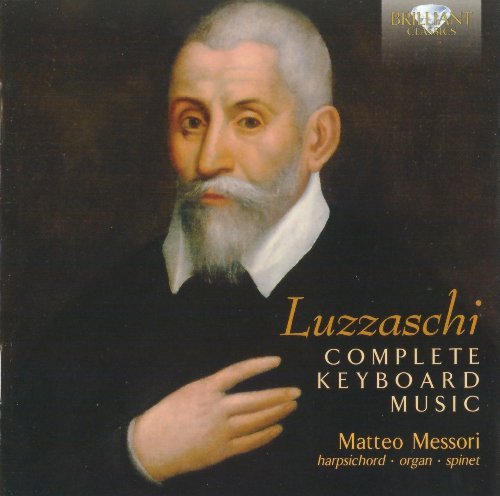
Matteo Messori - Luzzasco Luzzaschi: Complete Keyboard Music (2014)
BAND/ARTIST: Matteo Messori
- Title: Luzzasco Luzzaschi: Complete Keyboard Music
- Year Of Release: 2014
- Label: Brilliant Classics
- Genre: Classical
- Quality: FLAC (image + .cue, log, scans)
- Total Time: 72:00 min
- Total Size: 424 MB
- WebSite: Album Preview
Tracklist:
01] Toccata del quarto tuono
Il Secondo Libro de Ricercari a quattro voci
02] Ricercar Primo
03] Ricercar Secondo
04] Ricercar Terzo
05] Ricercar Quarto
06] Ricercar Quinto
07] Ricercar Sesto
08] Ricercar Settimo
09] Ricercar Ottavo
10] Ricercar Nono
11] Ricercar Decimo
12] Ricercar Undecimo
13] Ricercar Duodecimo
14] Ricercare del Primo Tuono a 4
15] Ricercare del Secondo Tuono a 4
16] [Canto fermo] a4 [sopra 'la Spagna']
17] [Canto fermo] a quattro sopra Ave Maris Stella (attribution)
18] Canzona
01] Toccata del quarto tuono
Il Secondo Libro de Ricercari a quattro voci
02] Ricercar Primo
03] Ricercar Secondo
04] Ricercar Terzo
05] Ricercar Quarto
06] Ricercar Quinto
07] Ricercar Sesto
08] Ricercar Settimo
09] Ricercar Ottavo
10] Ricercar Nono
11] Ricercar Decimo
12] Ricercar Undecimo
13] Ricercar Duodecimo
14] Ricercare del Primo Tuono a 4
15] Ricercare del Secondo Tuono a 4
16] [Canto fermo] a4 [sopra 'la Spagna']
17] [Canto fermo] a quattro sopra Ave Maris Stella (attribution)
18] Canzona
The Ferraraborn Luzzasco Luzzaschi might not exactly be a household name, but his contribution to the development of the madrigal places him within that elite category of composers who helped shape the course of music history. The favourite musician of Duke Alfonso II, the last of the legitimate dEste (the most intellectual and cultivated dynasty of Renaissance Italy) it was Luzzaschi who, in his role as the finest keyboard player of the period, cultivated the open score approach to performance. This was essentially a sort of motet of madrigal without words that focused on highly refined counterpoint and on the complexity of fugues i.e. fourvoice writing, without recourse to embellishment or any added prettiness.
Only the second of the composers three books of ricercari, as detailed in this recording, has survived a regrettable fact, given that the 1578 manuscript is unrivalled in its complexity among keyboard music of the second half of the 16th century. The book also comprises the only known freeform composition by Luzzaschi, the melancholic Toccata del quarto tuono; also included on the recording are two counterpoints on the plainchants La Spagna and Ave Maris stella, as well as the simple, unpretentious Canzona Maestro Messoris keyboard arrangement of an ensemble piece published in the Raveri collection of Canzoni per sonare con ogni sorte di stromenti (1608) by various composers.
Indeed, Messoris interest in and understanding of this period of music history is confirmed by his critical open score edition used for the recording (shortly to be published by Ut Orpheus at the time of writing), as well as his assured performances. Using different Italian harpsichords to convey a sense of chamber music, in addition to the organ and spinet, he conjures up the refinement and splendour of the Ferrarese court with ease and grace, presenting a strong case for why this Renaissance composer and former teacher of Frescobaldi, who further cultivated keyboard openscore notation deserves to be betterknown.
Only the second of the composers three books of ricercari, as detailed in this recording, has survived a regrettable fact, given that the 1578 manuscript is unrivalled in its complexity among keyboard music of the second half of the 16th century. The book also comprises the only known freeform composition by Luzzaschi, the melancholic Toccata del quarto tuono; also included on the recording are two counterpoints on the plainchants La Spagna and Ave Maris stella, as well as the simple, unpretentious Canzona Maestro Messoris keyboard arrangement of an ensemble piece published in the Raveri collection of Canzoni per sonare con ogni sorte di stromenti (1608) by various composers.
Indeed, Messoris interest in and understanding of this period of music history is confirmed by his critical open score edition used for the recording (shortly to be published by Ut Orpheus at the time of writing), as well as his assured performances. Using different Italian harpsichords to convey a sense of chamber music, in addition to the organ and spinet, he conjures up the refinement and splendour of the Ferrarese court with ease and grace, presenting a strong case for why this Renaissance composer and former teacher of Frescobaldi, who further cultivated keyboard openscore notation deserves to be betterknown.
Classical | FLAC / APE | CD-Rip
As a ISRA.CLOUD's PREMIUM member you will have the following benefits:
- Unlimited high speed downloads
- Download directly without waiting time
- Unlimited parallel downloads
- Support for download accelerators
- No advertising
- Resume broken downloads


